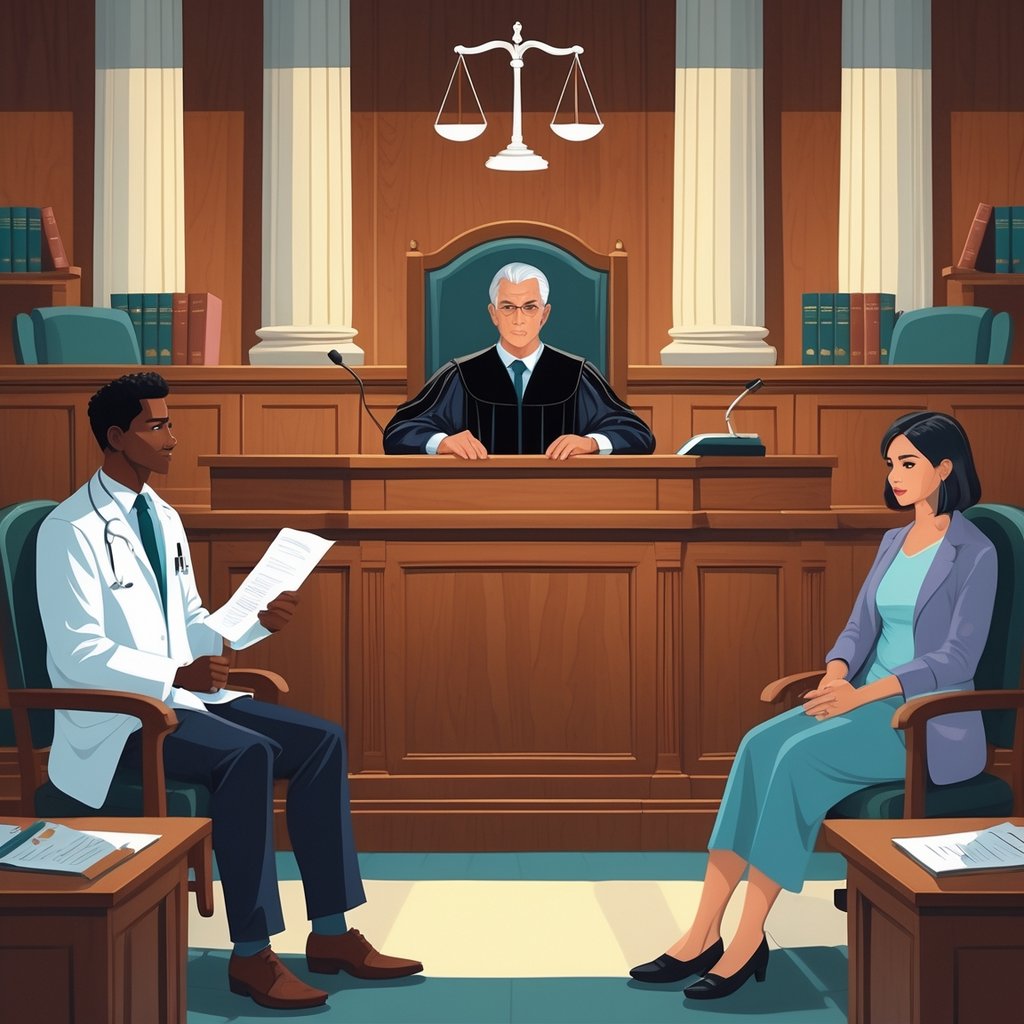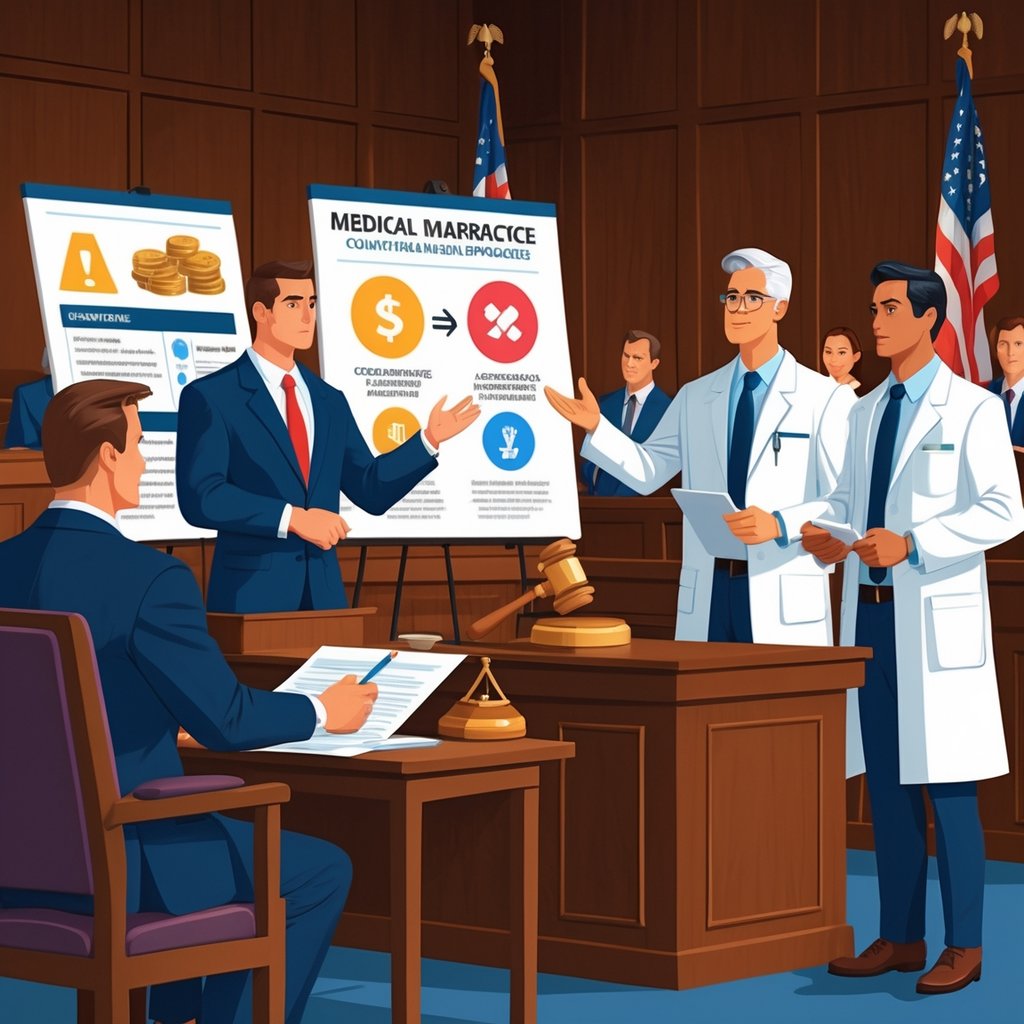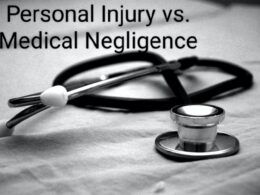When you’re staring down a possible medical malpractice claim, it’s natural to wonder if your story will play out in a courtroom. Most of these cases actually never make it that far.
About 90% to 95% of medical malpractice cases settle out of court. Only 5% to 7% ever go to trial, so seeing one through to a jury is pretty rare.

Why do so few cases go all the way to trial? Patients and healthcare providers both want to skip the stress, the cost, and the long wait that comes with a full-blown trial.
Dragging a case through court can take years. It’s expensive for everyone involved.
If you’re thinking about filing, knowing what’s ahead can help you stay sane and work better with your attorney. The choice between settling and going to trial isn’t simple.
It depends on a bunch of factors that shape your outcome and the kind of compensation you might see.
Key Takeaways
- Nearly 95% of medical malpractice cases settle out of court
- Trials involve jury selection, expert witnesses, and can last months or even years
- Settlements move faster, but trials could mean bigger payouts—with more risk
How Often Do Medical Malpractice Cases Go to Trial?

Most of the time, medical malpractice claims settle before anyone ever sees a jury. Only about 5% to 7% reach trial.
The rest either settle or get tossed out altogether.
Statistics on Medical Malpractice Trials
The numbers are pretty clear—medical malpractice trials don’t happen often. From 2005 to 2009, 96.9% of paid claims settled outside court, while just 3.1% ended with a judgment.
About 80-90% of these cases settle before trial. If you file a claim, your odds of facing a jury are less than 10%.
Trial Stats at a Glance:
- 7-10% go to jury trial
- 3-5% end with a court verdict
- 90-95% settle
- Over half get dismissed
Doctors usually win when these cases do go to trial. Physicians get favorable verdicts in 80% to 90% of weak-evidence cases and 50% of strong-evidence cases.
Major Reasons Most Cases Settle
A lot pushes these cases toward settlement. Money is a big one.
Financial pressure drives many people to settle. Trials rack up huge bills for both sides. Medical malpractice cases can get really technical, and juries might not always understand the details. Litigation costs add up fast.
Time matters, too. Non-litigated claims wrap up in about 11.6 months, while those that go to court take 25.1 months.
Risk assessment is part of the equation. Both sides weigh their odds before settling.
Reputation is on the line for healthcare providers. They’d rather settle quietly than risk bad press.
Expert witnesses are expensive. Their fees can be sky-high, and their opinions might clash.
Trends in Malpractice Dispute Resolution
Settlements have pretty much been the norm for years now. Most cases follow a familiar path.
Negotiations often start early. Attorneys and insurance reps usually talk settlement before things get too heated.
Mediation and other alternatives are gaining traction. These routes help everyone avoid the unpredictability of a jury.
A lot of claims get dismissed. About half or more don’t make it past the early stages, often because of weak evidence or technical problems.
High-stakes cases—the ones with serious injuries or death—are more likely to go to trial. Minor injury claims? Not so much.
Understanding the Medical Malpractice Trial Process

If your case does go to trial, get ready for a long and detailed process. There’s a lot of prep, jury selection, and expert testimony to prove medical negligence.
Pre-Trial Procedures and Discovery
Before your trial even starts, you and your lawyer spend months—maybe years—gathering evidence. This means collecting medical records, lining up expert witnesses, and building your argument.
Key pre-trial steps:
- Find and hire medical experts
- File briefs to lay out your arguments
- Send proposed jury instructions to the judge
- Exchange evidence with the defense
Your team needs to show three things. First, what the standard of care was. Second, how the provider missed it. Third, how that mistake caused your injuries.
Expert witnesses matter a lot here. They review your case and get ready to explain if the right medical steps were followed.
Jury Selection and Opening Statements
The trial kicks off with jury selection, called voir dire. Lawyers or the judge ask questions to see if jurors can be fair.
Sometimes lawyers get to ask directly. Other times, judges handle it and use questions from both sides.
Once the jury’s set, both attorneys give opening statements. Your lawyer lays out your story and what the jury should expect. The defense lawyer gives their version and argues the provider did nothing wrong.
Opening statements set the stage but don’t count as evidence.
Presenting Evidence and Closing Arguments
Your side goes first in the evidence phase. You’ll call expert witnesses to talk about the standard of care and how it was missed.
Your team needs to prove:
- What the doctor should have done
- How the provider missed the mark
- The damages you suffered
Both sides get to question witnesses. You might end up testifying about how this affected your life.
After all the evidence is in, lawyers make closing arguments. They highlight the key points and try to sway the jury.
The judge then reads out instructions for the jury to follow.
Jury Deliberation and Verdict
The jury heads off to decide if malpractice happened. States have different rules about how many jurors need to agree.
Jurors can submit written questions if something’s unclear. They look over the evidence, medical records, and expert testimony.
If they find for you, they decide on damages. Types of damages:
- Economic: Medical bills, lost wages, future care
- Non-economic: Pain, suffering, loss of enjoyment
- Punitive: Extra punishment for especially bad conduct (rare)
Once the verdict’s in, the judge announces it in court. The losing side can appeal, which might delay any payout.
Factors That Influence Whether a Case Goes to Trial

A few big things decide if your case goes to trial or settles. The strength of your evidence, the financial risks, and personal factors all come into play.
Strength of Evidence and Expert Testimony
Your case stands or falls on good evidence and credible experts. Attorneys look for clear proof of negligence and a direct link to your injury.
Strong evidence includes:
- Medical records that show clear mistakes
- Multiple experts backing you up
- Documentation of the provider’s errors
- A direct connection between the error and your harm
If your evidence is shaky or experts disagree, providers are more likely to take the fight to court. They might think a jury won’t side with you.
Most cases settle when one side’s evidence is much stronger. Your attorney will weigh if your proof meets the bar for trial.
Expert testimony can make or break things. If respected experts support you, the other side may settle rather than risk a loss in court.
Risk Assessment for Plaintiffs and Defendants
Both sides look at what they stand to lose or gain. Doctors win about three out of four cases that go to trial, so it’s a gamble for patients.
Your risks:
- Only a 20-30% chance of winning at trial
- The stress of years in court
- No guarantee of money
- Your medical story goes public
Provider risks:
- Big jury awards if they lose
- Damage to their name
- Legal fees that might top settlement costs
- Time away from patients for court
How much you’re seeking matters. Serious injuries or deaths are more likely to go to trial, since settlements might not cover what you want.
Lawyers help you weigh these risks before you decide.
Emotional and Financial Considerations
The emotional and financial strain of a lawsuit matters more than most people expect. Legal fees can reach hundreds of thousands.
Money factors:
- Expert witnesses charge $500 to $1,000 an hour or more
- Reviewing records and reports isn’t cheap
- Court costs add up
- You might wait years for any resolution
Families often need money now for care. Settling gets you paid quicker than waiting for a verdict.
Some providers choose trial, hoping not to admit fault, even if settling would cost less. Insurance companies often call these shots.
You need to be ready emotionally, too. Trials can mean reliving trauma on the stand.
Attorneys work with you to balance all this—money, emotions, and your odds at trial.
Settlement Versus Trial: Key Differences and Outcomes

Most medical malpractice cases end with settlement talks or a jury trial. Each path has its own upsides and risks.
Physicians win 80% to 90% of jury trials when evidence is weak, so the strength of your case really matters when deciding which way to go.
Pros and Cons of Settling Out of Court
Advantages of Settlement:
- Faster resolution: Most cases settle within months, not years.
- Guaranteed compensation: You get paid without taking on trial risks.
- Lower costs: Legal fees and expenses usually stay much lower.
- Privacy protection: Settlement details remain private, unlike public trials.
- Reduced stress: You avoid long depositions and stressful court appearances.
Disadvantages of Settlement:
- Lower compensation: Settlements are usually less than what a trial might award.
- No admission of guilt: Healthcare providers don’t have to take responsibility.
- Limited precedent: Settlements don’t set legal standards for future cases.
Most medical malpractice cases settle out of court. Both sides want to skip the drawn-out legal process. Hospitals and doctors often settle to avoid unpredictable jury awards.
Advantages and Disadvantages of Going to Trial
Trial Benefits:
- Higher compensation potential: Juries sometimes award large sums for pain and suffering.
- Public accountability: Trials create an official record of what happened.
- Punitive damages possible: The court can add penalties for especially bad conduct.
- Professional consequences: A verdict can hurt the defendant’s license or reputation.
Trial Drawbacks:
- Uncertain outcomes: Even strong cases win only about half the time.
- Extended timeline: Trials drag on, sometimes for 2 to 4 years.
- Higher expenses: Attorney fees, expert witnesses, and court costs add up quickly.
- Emotional toll: Testifying and being cross-examined takes a lot out of you.
Going to trial involves weighing potential risks and gains based on your case’s details.
Impact on Compensation and Accountability
Compensation Differences:
Settlement amounts usually fall well below trial awards. Research shows settlements for poor medical care average about $203,209. Similar trial wins reach $765,486.
Medical expenses: Both settlements and trials cover your medical costs, past and future.
Pain and suffering: Trial awards often give more for emotional and physical pain.
Accountability Measures:
Settlements rarely force anyone to admit wrongdoing. Healthcare providers keep practicing without admitting mistakes.
Trials put findings of negligence on the record. The malpractice system provides substantial incentive for high quality medical care when cases go to verdict.
Financial Recovery Patterns:
| Case Strength | Settlement Rate | Average Settlement | Trial Win Rate |
|---|---|---|---|
| Weak Evidence | 21% | $14,109 | 10-20% |
| Unclear Evidence | 59% | $146,160 | 30% |
| Strong Evidence | 91% | $203,209 | 50% |
Types of Damages in Medical Malpractice Litigation

When medical malpractice cases reach trial, three main categories of damages can determine your compensation. These include economic losses like medical bills and lost income, non-economic damages for pain and suffering, and punitive damages for severe misconduct.
Compensatory Damages: Medical Expenses and Lost Wages
Compensatory damages pay for your actual financial losses. These quantifiable economic damages include all medical expenses, both now and in the future.
Medical expenses you can claim:
- Hospital bills and surgeries
- Medication and medical devices
- Physical therapy and rehab
- Future medical care
- In-home nursing help
Your medical expenses might go far beyond the first hospital stay. If a birth injury leads to lifelong care, you can claim those future costs, too. Medical experts help estimate long-term expenses.
Lost wages cover the income you can’t earn because of your injury. This includes time off work while you recover and any permanent disability that limits your future earning power.
You can ask for both past lost income and what you’ll lose down the road. If your injury keeps you from your old job or limits your career, those losses become part of your compensatory damages.
Non-Economic Damages: Pain and Suffering
Non-economic damages pay for losses that don’t have a clear price tag. Pain and suffering damages try to address how your injury changed your life.
Pain and suffering can include:
- Physical pain
- Mental anguish and emotional distress
- Loss of enjoyment in hobbies and activities
- Disfigurement or permanent disability
- Loss of companionship with a spouse
Some losses can’t be measured in bills or paychecks. If a doctor’s error keeps you from playing sports or caring for your kids, money doesn’t really fix it, but it’s something.
Many states cap these damages. Nearly 30 states have laws that limit what you can get for pain and suffering, no matter what the jury decides.
Punitive Damages and When They Apply
Punitive damages punish healthcare providers for especially bad conduct. These don’t pay you back for losses—they penalize wrongdoers and try to send a message. Punitive damages penalize wrongdoers and deter similar behavior.
Punitive damages apply when providers show:
- Willful misconduct or malice
- Reckless disregard for patient safety
- Intentional cover-ups or fraud
Most malpractice cases don’t qualify for punitive damages. Simple mistakes or bad judgment don’t meet the high bar.
Courts award punitive damages when a doctor hides mistakes or acts with obvious disregard for your safety. These cases involve clear, intentional wrongdoing.
The rules on punitive damages change a lot from state to state. Some states ban them in medical malpractice entirely. Others allow big awards if the conduct is really egregious.
The Role of Medical Malpractice Attorneys

Medical malpractice attorneys take on tough legal work that needs real knowledge of both law and medicine. They handle everything from picking the right lawyer to understanding costs and what happens in court.
Selecting the Right Legal Representation
Getting the right medical malpractice attorney can make a huge difference. You want someone who focuses on medical malpractice, not just general injury law.
Key things to look for:
- Experience with similar cases: Find attorneys who’ve handled cases like yours.
- Trial record: Some lawyers settle everything. The best results often come from lawyers ready to go to trial.
- Medical expert network: Good lawyers work with qualified medical experts.
- Resources: Malpractice cases are expensive and need real investment up front.
These lawyers need to understand complex medical issues. They have to work closely with doctors and other experts to figure out what went wrong.
Ask about their success rate and recent results. Most reputable attorneys offer free consultations to review your case.
Attorney Responsibilities During Trial
Your attorney manages a lot before and during trial. Medical malpractice cases involve complex legal and medical issues that need careful prep.
Pre-trial work includes:
- Gathering all medical records and evidence
- Working with experts to show negligence
- Filing legal paperwork and hitting deadlines
- Handling discovery and depositions
During trial, your attorney presents evidence to the judge or jury. They question witnesses and experts and cross-examine the other side.
Good malpractice attorneys translate medical jargon into plain English. The jury needs to understand what happened and how it hurt you.
Your lawyer also handles settlement talks, which can happen at any stage. Most cases actually settle before a verdict.
Importance of Legal Fees and Cost Considerations
Medical malpractice cases cost a lot to bring. Most attorneys work on a contingency fee, meaning they only get paid if you win.
Common fee structures:
| Fee Type | Percentage | When Paid |
|---|---|---|
| Contingency | 33-40% | Only if you win |
| Hourly | $300-800/hour | Regardless of outcome |
Typical case expenses:
- Medical expert fees ($500-1,000 per hour)
- Court filing costs
- Medical record fees
- Deposition transcripts
Most attorneys front these costs for you. If you lose, you usually don’t pay them back. If you win, the costs come out of your settlement.
Legal fees can eat up a big chunk of your recovery, so make sure you understand all costs before signing anything. Some attorneys charge more if the case goes to trial instead of settling.
Frequently Asked Questions

Most medical malpractice cases settle before trial. Only about 10 percent ever go to court. Settlement amounts, trial timelines, and the decision to settle or go to trial depend on several things—case strength, costs, and risk.
What percentage of medical malpractice cases are settled without going to trial?
Roughly 10% of medical malpractice cases go to trial. That means about 90 percent settle or get dismissed. Odds are, you’ll never see a courtroom.
The majority of medical malpractice cases are settled before they go to trial. Both sides want to avoid the time and expense. Insurance companies almost always prefer to settle instead of risking a huge jury award.
What are the common reasons medical malpractice cases may settle before reaching the courtroom?
Time and cost drive most settlements. Medical malpractice trials involve months or years of pre-trial investigation, which gets expensive.
Both sides worry about losing in court. Defendants want to skip the risk of a big verdict. Plaintiffs sometimes just want guaranteed compensation instead of gambling it all at trial.
Settlement talks let you control the outcome a bit more. You can work out specific terms and avoid the stress and publicity of a public trial.
How do settlement amounts typically compare to trial verdicts in medical malpractice cases?
Settlements usually pay less than what you might win at trial. Insurance companies offer less to account for their risks and costs.
If you win at trial, the verdict can be much higher. But there’s always a risk you walk away with nothing if the jury sides with the defense.
It all depends on your case’s facts and strength. Clear liability often means higher settlement offers, closer to what you might win at trial.
What are the potential disadvantages for a plaintiff when a medical malpractice case goes to trial?
You could lose everything at trial. If the jury finds no malpractice, you get nothing after years of fighting.
Trials cost a lot and take a long time. You’ll spend money on experts, court fees, and attorney costs with no guarantee you’ll recover anything.
The process is emotionally tough. Medical malpractice trials are often arduous and adversarial. You might have to relive traumatic experiences in public.
Even if you win, appeals can hold up payment for years. The defendant might appeal, and you won’t see any money until the appeals process ends.
How long does the typical medical malpractice case take to resolve, through settlement or trial?
Medical malpractice cases usually take anywhere from 12 to 36 months to get to trial after you file your lawsuit. This timeline covers a lot of pre-trial work and discovery.
Settlement talks can start at any stage. Some cases wrap up in just a few months.
Others drag on for years, especially if things get complicated or people dig in their heels. Cases that reach trial usually take even longer.
The trial itself might last just a few days or stretch into weeks. If anyone appeals, the whole thing can drag out for years after that.
What factors influence if a medical malpractice lawsuit will end in a settlement or proceed to trial?
The strength of your case plays a major role. Clear evidence of medical negligence and significant damages make settlements more likely.
Disputed liability often pushes things to trial. Your willingness to accept reasonable offers also affects the outcome.
If settlement negotiations stall because either side has unrealistic expectations, trials become more likely. The defendant’s insurance coverage and policy limits steer decisions too.
When damages exceed policy limits, you might need to go to trial to recover full compensation. A case going to trial or settling depends on your attorney’s strategy and the unique details of your medical treatment. Sometimes it really comes down to the specifics.











